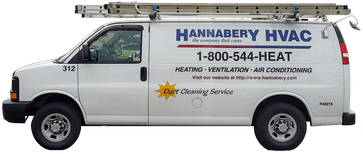FAQ's - Frequently Asked Questions:
Copyright © 1997 Hannabery HVAC. All rights reserved.
What are the Benefits of a Variable Speed Furnace or Air Handler?
Also, what is a Two-Stage Furnace?

What is a Variable Speed Furnace or Air Handler?

The term "Variable Speed" actually refers to the blower motor inside the furnace or air handler. It's an Electronically commutated motor, or (ECM). ECM's are DC motors that function using a built-in inverter and a magnet rotor, and as a result are able to achieve greater efficiency than most AC motors.
ECMs are low-maintenance, energy efficient, and can reduce operating costs. The initial cost of a furnace with an ECM will be higher than a traditional furnace, but the typical payback on a variable speed furnace is just 4 to 5 years.
How Does it Work?
Unlike conventional fan motors, a variable speed blower motor runs at different speeds to precisely control the flow of heated or cooled air throughout your home. Better airflow control means a better balance of temperature and humidity.
Using advanced technology, it constantly monitors the data coming from your heating and cooling system, and automatically makes adjustments necessary to meet your comfort needs. It varies the amount of circulated air, compensating for factors like dirty filters or blocked vents by increasing the fan speed.
Put simply, it delivers just the right amount of air for the right level of heating and cooling comfort.
As an added bonus, a variable speed motor gradually ramps up to full speed. This eliminates the sudden, noisy blast of air that’s associated with standard furnace motors. It also reduces stress on the mounting hardware. And in the cooling mode, it allows the air conditioner to remove more moisture from the air.
- A variable speed heating system precisely controls airflow to provide better temperature control, humidity control and air distribution. A higher degree of precision means a higher level of comfort.
- Compared to a conventional single-speed furnace, a variable speed furnace performs better and uses about two-thirds less electricity. During the cooling mode, variable speed systems typically result in an efficiency gain of about 1 SEER (Seasonal Energy Efficiency Ratio). The higher the SEER, the lower your utility bills. All of this, over the course of just one year, can add up to hundreds of dollars off your electric bill!
- A variable speed furnace or air handler also ensures quieter operation. The furnace slowly ramps up to speed, so there’s no sudden "kick" or "blast" of air at startup.
- A variable speed motor can also help better clean the air in your home. When the fan is in constant operation (indicated by the "Fan" setting on your thermostat), the motor will continue to slowly circulate air, allowing your air filters to capture more contaminants.
What is a Two-Stage Furnace?
A two-stage furnace operates much more efficiently than a single-stage furnace. It provides the right amount of heat to efficiently satisfy your home and family's needs. In addition, a two-stage furnace is much quieter since it doesn't operate at 100% capacity every time it runs, and creates less carbon dioxide emissions for the environment.
If you are in the market for a new gas furnace, then without a doubt, a variable-speed, two-stage furnace would be your best choice! And the same applies to heat pumps. Many are available with two-speed compressors and variable-speed air handlers for the ultimate in comfort and efficiency.
How Does it Work?
For most climates, the first stage operates the majority of the time, and runs at about 65% of the furnace's full capacity. When the temperature outside becomes extremely cold and the first stage is not sufficient enough to heat your home, the second stage kicks on to provide the additional heat requirements. This allows warm air to be distributed into your home more evenly, which helps to reduce air fluctuations.
Two-stage furnaces also help to increase energy efficiency on moderate-temperature days since they will, in most cases, remain on the low stage. They also provide a higher level of comfort due to a steady flow of warm air on the coldest winter days.
FYI: "Variable Speed" refers to the blower motor - how much air it moves through the ductwork. "Two-Stage" refers to the gas valve and burners - basically how much heat the furnace puts out.
Please keep in mind that the information found on our website is provided free of charge and Hannabery HVAC does not assume any liability resulting from the information we provide. We hope this information helps, but please note that these are just rough guidelines, and not all possible situations are covered. Your HVAC system should be inspected and repaired by a trained technician.
How Comfortable Do You Want To Be?
[Must be in our service area]

